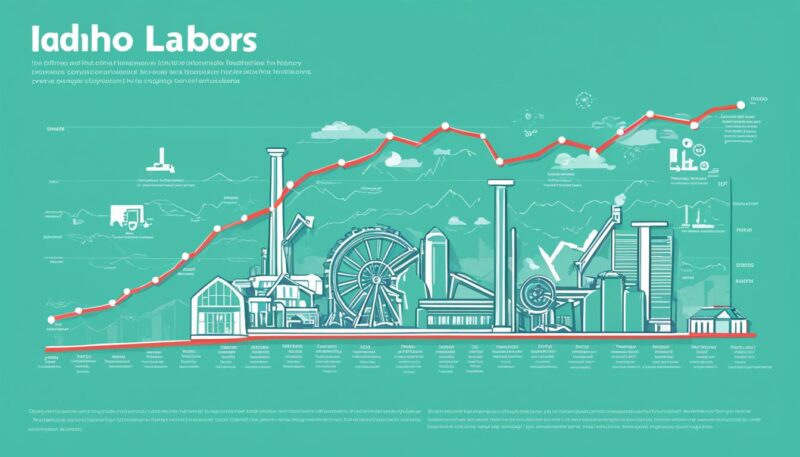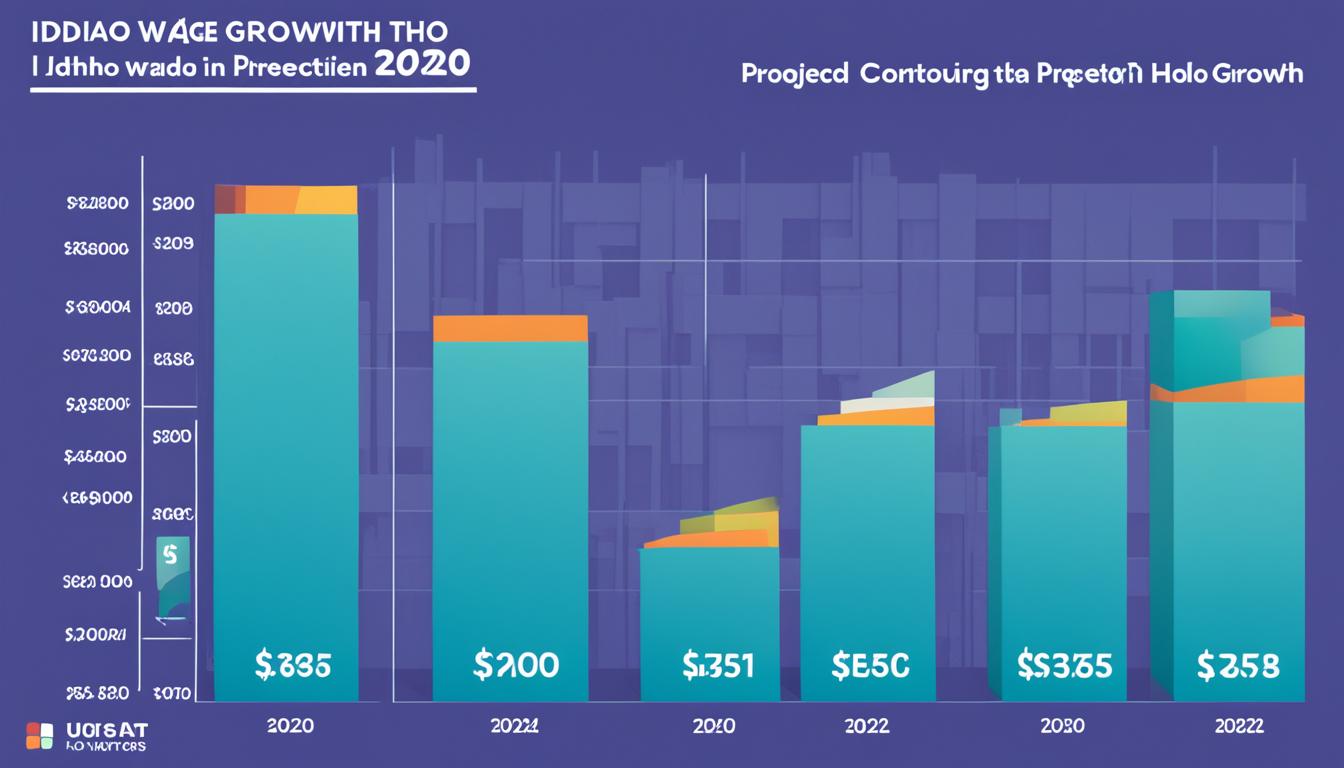The job market in Idaho stands at a pivotal point in 2024, with wage growth projections promising insights into the future economic vitality of the state. This analysis delves deep into Idaho wage growth projections for 2024, utilizing a comprehensive Idaho job market analysis and Idaho income data analysis. By interpreting the trends and legislative changes that impact these projections, this study provides an invaluable resource for workers, employers, and policymakers alike.
Understanding the trajectory of wages in the Gem State requires not only a look at numbers and statistics but also an in-depth consideration of the diverse factors influencing them. These include the cost of living, economic developments, and job market shifts that are shaping the financial landscape of the state. Join us as we uncover what the coming year holds for Idaho’s workforce and economic structure.
Key Takeaways
- Delve into 2024’s wage growth projections for a clear understanding of Idaho’s financial forecast.
- Analyze current job market trends to anticipate future employment opportunities in Idaho.
- Review Idaho’s income data analysis for a comprehensive perspective on statewide earnings.
- Explore the factors influencing wage variations, including legislative changes and economic shifts.
- Gain actionable insights that can guide stakeholders in making informed decisions about the future.
Overview of Idaho’s Wage Landscape
As the calendar turns to 2024, the Gem State continues to shine a light on its changing economic indicators, particularly within the realm of wages. The Idaho minimum wage 2024 has become a focal point for many, signifying an essential benchmark in the ongoing narrative of the state’s labor market trends. Not just a figure of procedural incremental change but a litmus test for the robustness of the local economy, Idaho’s wage policies reflect a broader canvas colored by legislative developments and regional competitiveness.
Understanding the Idaho Minimum Wage in 2024
Staying savvy about the Idaho minimum wage in 2024 is paramount not just for employees and employers within the state but also for those eyeing the region’s evolving job sector dynamics. As cost-of-living adjustments take center stage, the minimum wage serves as an indicator of purchasing power and economic health for the state’s workforce. Idaho salary statistics 2024 continue to be scrutinized, as they provide transparent insight into the financial solvency and viability of living and working in Idaho.
The Role of Legislation in Shaping Wage Trends
Idaho’s capitol, where policy shapes the daily lives of its citizens, plays a crucial role in setting the financial tempo through legislation. Wage trends, oftentimes seen as the pulse of the labor market, are influenced heavily by state laws that determine the floor for wages. These legislative decisions not only impact those at the bottom rung of the earning ladder but also reverberate through the entirety of Idaho labor market trends, setting a precedent that influences wage negotiations across sectors.
Comparison with Surrounding States
In the greater tapestry of the American West, Idaho does not operate in isolation. An elucidating comparison with surrounding states unveils vital regional labor market trends and lends perspective to Idaho’s position within the intermountain corridor. These comparative metrics offer a narrative of cooperation and competition, as Idaho salary statistics 2024 are contrasted against states like Montana, Wyoming, and Utah, crafting a multifaceted view of regional economics.
Idaho Labor Market Trends
The Idaho job market has seen a substantial evolution in recent years, influenced by a variety of economic factors. An analysis of Idaho labor market trends indicates a significant flux within the employment landscape, particularly concerning the balance between full-time and part-time positions. The burgeoning industries are not only affecting the number of jobs available but also the type of employment being offered. Below we delve into the specifics of these trends and their implications.
Industry and Employment Growth: One of the hallmarks of the state’s economic advancement is the growth within certain industries. Technology and healthcare sectors are leading in job opportunities, with a noticeable surge in demand for skilled professionals.
- Technology firms are setting up bases in Idaho due to the favorable business climate and availability of a talented workforce.
- Healthcare providers are expanding their services in response to the state’s growing population.
Full-time vs. Part-time Employment Shifts: With the rise of the gig economy and changes in employer needs, there is a noted shift from traditional full-time employment to more flexible, part-time work arrangements. This shift is reflective of broader national labor market trends but shows unique characteristics within Idaho’s diverse economic regions.
- Increased part-time, contract, and contingent job openings in urban centers like Boise.
- More full-time positions available in agricultural and manufacturing sectors outside metro areas.

Wages and Sectoral Impact: As employment types shift, so too do wages, with full-time positions typically offering higher stability and benefits over part-time roles. Here is a representative analysis of how these factors are influencing wages:
| Industry | Full-time Employment Growth | Part-time Employment Growth | Average Wage Impact |
|---|---|---|---|
| Technology | Rising | Stable | Positive Impact |
| Healthcare | Stable | Rising | Varied Impact based on position |
| Agriculture | Stable | Seasonal Fluctuations | Neutral Impact |
| Retail | Decreasing | Rising | Negative Impact |
Economic Trajectory Indicators: The analysis of labor trends also serves as a bellwether for broader economic forecasts. A consistent increase in full-time employment within key sectors suggests a robust economic outlook, whereas a surge in part-time employment raises concerns about job security and the potential for wage stagnation.
Idaho’s job market analysis reveals an adaptable and dynamic labor landscape, with a lean towards more non-traditional employment forms. As such, both businesses and workers are encouraged to remain agile and forward-thinking to thrive in this changing market.
Idaho Salary Statistics 2024
As the year 2024 progresses, Idaho’s economic landscape reveals significant data pertaining to the evolving compensation patterns across various industries. With a focus on the Idaho salary statistics for 2024, this section aims to shed light on the average salary ranges in key sectors, discrepancies between male and female earnings highlighting the Idaho gender wage gap, and the contrasts in income between urban and rural areas. This Idaho income data analysis endeavors to provide a comprehensive understanding of the financial scenario for employees in the Gem State.
Average Salary Ranges in Key Sectors
Idaho’s diverse economic structure encompasses several predominant industries, each offering distinct remuneration scales. Agriculture, manufacturing, and technology stand out as significant contributors to the state’s salary landscape.
Notable sectors such as healthcare and education also play a pivotal role in shaping the overall compensation framework. Below, a detailed breakdown of average salary ranges in these key sectors is presented:
| Sector | Average Salary Range |
|---|---|
| Technology | $75,000 – $120,000 |
| Healthcare | $50,000 – $100,000 |
| Education | $40,000 – $70,000 |
| Manufacturing | $35,000 – $85,000 |
| Agriculture | $30,000 – $75,000 |
Gender Wage Gap Analysis
Despite advancements, the gender wage gap continues to be a pressing concern in Idaho. The disparity in earnings between males and females persists, influencing the state’s drive towards achieving equitable compensation practices.
An in-depth gender wage gap analysis reveals that women in Idaho earn approximately 78% of what their male counterparts earn for comparable roles.
Salary Comparisons: Urban vs. Rural
Idaho’s geographic and demographic diversity leads to substantial variation in salary ranges between urban centers and rural areas. The urban centers, such as Boise and Meridian, often offer higher average salaries compared to rural regions, due to the concentration of corporate entities and advanced service sectors.
Contrarily, rural areas, while benefitting from agricultural and manufacturing sectors, typically exhibit lower wage averages, reflecting the economic activities predominant in these regions. The table below encapsulates this urban-rural divide:
| Location | Average Urban Salary | Average Rural Salary |
|---|---|---|
| Boise | $55,000 | $45,000 |
| Meridian | $53,000 | $43,000 |
| Idaho Falls | $50,000 | $40,000 |
| Twin Falls | $48,000 | $38,000 |
| Coeur d’Alene | $47,000 | $37,000 |
Idaho Income Data Analysis and Projections
As we delve into the intricate fabric of Idaho’s economy, a comprehensive review of the state’s income data reveals critical insights that pave the way for projected wage growth trends. The narrative of income evolution in the state is multifaceted, influenced by demographic shifts, industry developments, and educational attainment among others.
Underpinning our Idaho income data analysis is the examination of key sectors that are catalyzing economic momentum. These sectors are extrapolated to forecast Idaho wage growth projections for 2024, reflecting the dynamism present in the state’s labor market. Herein lays a table that illustrates the projected wage growth in various sectors:
| Sector | Projected Wage Growth | Contributing Factors |
|---|---|---|
| Technology | 4.8% | Increased demand for software and network infrastructure |
| Healthcare | 3.5% | Aging population and expansion of healthcare services |
| Construction | 3.0% | Growth in housing demand and infrastructure projects |
| Agriculture | 2.5% | Advancements in agricultural technology and exports |
| Education | 2.2% | Investments in educational programs and faculty development |
The above data brings into perspective not just the numerical increments but the underlying forces at play. The projected wage growth aligns with Idaho’s commitment to nurturing industries that show resilience and adaptability in the face of economic fluctuations.
“The impressive strides in wage improvement signal Idaho’s robust economic groundwork, successfully setting the stage for sustained growth and prosperity,” says a lead economist at the Idaho Department of Labor.
This analytical foray also sheds light on the implications of demographic changes, such as urbanization rates, migration patterns, and the evolving composition of the workforce, all of which form integral aspects of wage determination.
- Migration to urban areas leading to greater demand for services with higher wages
- Persistent skills gap pushing up wages for specialized positions
- Favorable policies attracting businesses to settle, thus enhancing job creation
Ultimately, the Idaho wage growth projections for 2024 portray a state on the upward curve, capitalizing on its inherent strengths and seizing the opportunities presented by the market’s current trajectory.
Conclusion
In navigating through the complexities of wage patterns and employment landscapes, a thorough appreciation of Idaho wage growth projections for 2024 is indispensable. This analysis has shed light on pivotal elements that sculpt the fiscal fabric of the state. By dissecting data trends and legislative amendments, a lucid depiction of Idaho’s salary environment has emerged. There is a pronounced interplay between advancements in industry-specific wages and overarching economic strategies that define the future of employment in Idaho.
Crucial to this understanding is an evaluation against the Idaho cost of living index. As we have considered, the cost of living fundamentally underpins the adequacy and relative value of wages received by Idaho’s workforce. This benchmark is essential for stakeholders ranging from policy architects to businesses, as well as the labor force itself, all of whom stand to reap benefits from meticulously crafted economic directives informed by this scrutiny.
Therefore, when assessing the fiscal outlook for Wages in Idaho 2024, it remains paramount to place these insights in the context of actual living costs within the state. Whether for planning, negotiation, or policy formulation, equipping oneself with the knowledge of anticipated wage developments in relation to cost of living considerations is an invaluable stride towards ensuring sustainable economic prosperity for Idaho’s residents and business community alike.
